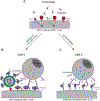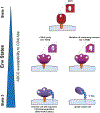Antibody-dependent cellular cytotoxicity in HIV infection
- PMID: 30234611
- PMCID: PMC6497078
- DOI: 10.1097/QAD.0000000000002011
Antibody-dependent cellular cytotoxicity in HIV infection
Abstract
: Interactions between the Fc segment of IgG and its receptors (FcγRs) found on cells such as natural killer cells, monocytes, macrophages and neutrophils can potentially mediate antiviral effects in the setting of HIV and related infections. We review the potential role of FcγR interactions in HIV, SIV and SHIV infections, with an emphasis on antibody-dependent cellular cytotoxicity (ADCC). Notably, these viruses employ various strategies, including CD4 down-regulation and BST-2/tetherin antagonism to limit the effect of ADCC. Although correlative data suggest that ADCC participates in both protection and control of established infection, there is little direct evidence in support of either role. Direct evidence does, however, implicate an FcγR-dependent function in augmenting the beneficial in vivo activity of neutralizing antibodies.
Figures


Similar articles
-
Enhanced neonatal Fc receptor function improves protection against primate SHIV infection.Nature. 2014 Oct 30;514(7524):642-5. doi: 10.1038/nature13612. Epub 2014 Aug 13. Nature. 2014. PMID: 25119033 Free PMC article.
-
Fc receptor-mediated antiviral antibodies.Curr Opin HIV AIDS. 2009 Sep;4(5):388-93. doi: 10.1097/COH.0b013e32832f0a89. Curr Opin HIV AIDS. 2009. PMID: 20048702 Free PMC article. Review.
-
Rapid Development of gp120-Focused Neutralizing B Cell Responses during Acute Simian Immunodeficiency Virus Infection of African Green Monkeys.J Virol. 2015 Sep;89(18):9485-98. doi: 10.1128/JVI.01564-15. Epub 2015 Jul 8. J Virol. 2015. PMID: 26157116 Free PMC article.
-
A MUC16 IgG Binding Activity Selects for a Restricted Subset of IgG Enriched for Certain Simian Immunodeficiency Virus Epitope Specificities.J Virol. 2020 Feb 14;94(5):e01246-19. doi: 10.1128/JVI.01246-19. Print 2020 Feb 14. J Virol. 2020. PMID: 31776284 Free PMC article.
-
Tfh1 Cells in Germinal Centers During Chronic HIV/SIV Infection.Front Immunol. 2018 Jun 6;9:1272. doi: 10.3389/fimmu.2018.01272. eCollection 2018. Front Immunol. 2018. PMID: 29928280 Free PMC article. Review.
Cited by
-
mRNA-based vaccine technology for HIV.Discoveries (Craiova). 2022 Jun 30;10(2):e150. doi: 10.15190/d.2022.9. eCollection 2022 Apr-Jun. Discoveries (Craiova). 2022. PMID: 36438441 Free PMC article. Review.
-
Presence of antibody-dependent cellular cytotoxicity (ADCC) against SARS-CoV-2 in COVID-19 plasma.PLoS One. 2021 Mar 4;16(3):e0247640. doi: 10.1371/journal.pone.0247640. eCollection 2021. PLoS One. 2021. PMID: 33661923 Free PMC article.
-
Metformin facilitates viral reservoir reactivation and their recognition by anti-HIV-1 envelope antibodies.iScience. 2024 Aug 5;27(9):110670. doi: 10.1016/j.isci.2024.110670. eCollection 2024 Sep 20. iScience. 2024. PMID: 39252967 Free PMC article.
-
A panel of hepatitis C virus glycoproteins for the characterization of antibody responses using antibodies with diverse recognition and neutralization patterns.Virus Res. 2024 Mar;341:199308. doi: 10.1016/j.virusres.2024.199308. Epub 2024 Jan 11. Virus Res. 2024. PMID: 38171391 Free PMC article.
-
Improved HIV-positive infant survival is correlated with high levels of HIV-specific ADCC activity in multiple cohorts.Cell Rep Med. 2021 Apr 20;2(4):100254. doi: 10.1016/j.xcrm.2021.100254. eCollection 2021 Apr 20. Cell Rep Med. 2021. PMID: 33948582 Free PMC article.
References
-
- Gorlani A, Forthal DN. Antibody-dependent enhancement and the risk of HIV infection. Curr HIV Res 2013; 11:421–426. - PubMed
-
- Kaifu T, Nakamura A. Polymorphisms of immunoglobulin receptors and the effects on clinical outcome in cancer immunotherapy and other immune diseases: a general review. Int Immunol 2017; 29:319–325. - PubMed
-
- Lohse S, Loew S, Kretschmer A, Jansen JHM, Meyer S, Ten Broeke T, et al. Effector mechanisms of IgA antibodies against CD20 include recruitment of myeloid cells for antibody-dependent cell-mediated cytotoxicity and complement-dependent cytotoxicity. Br J Haematol 2018; 181:413–417. - PubMed
Publication types
MeSH terms
Substances
Grants and funding
LinkOut - more resources
Full Text Sources
Other Literature Sources
Medical
Research Materials

